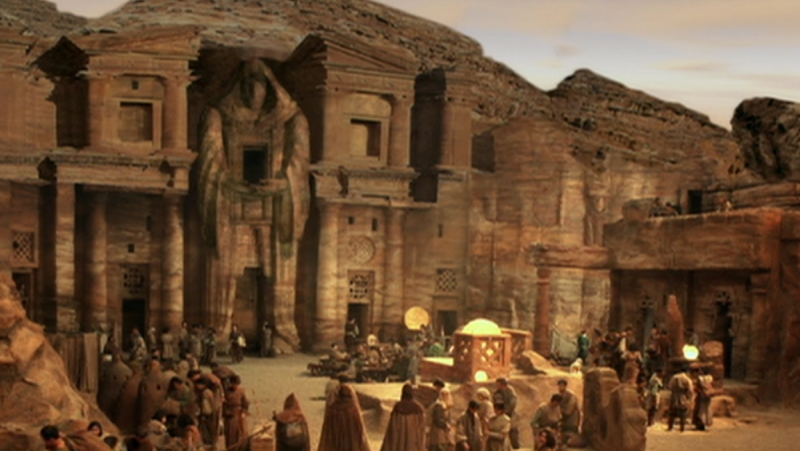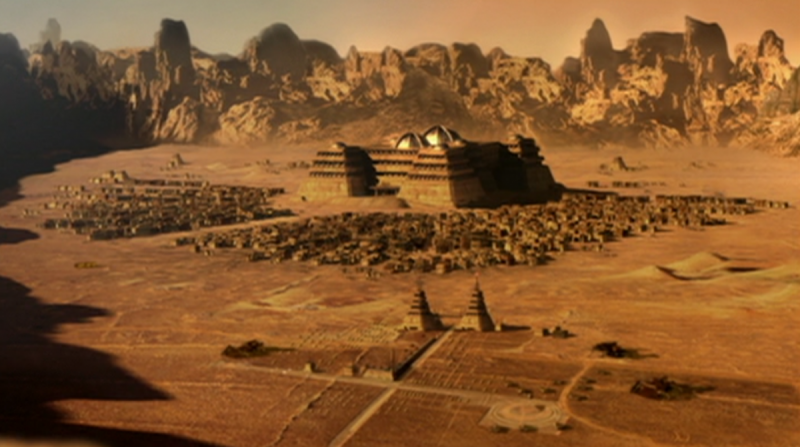What we can learn about urbanism from the sci-fi book Dune

Dune's planet Arrakis. Image from the Sci-Fi Channel.
We first published this article on January 6, 2017. We’re sharing it again so you can enjoy some sci-fi over the 4th of July weekend.
Frank Herbert’s Dune is one of the best-selling science fiction novels in history. Dune’s fictional universe has a number of parallels to resource use and the built environment in our world, from water shortages and overpopulation to the way places shape habits and personalities.
Herbert himself was a bit of an environmentalist. He and his family lived in Washington state, where he built a solar thermal collector and generated his own fuel. Herbert was inspired to write Dune after writing about the US Department of Agriculture’s attempts to add grasses to sand dunes to keep the sand from shifting.
Dune has a lot to teach us about how density relates to resource availability
Dune was one of the first science fiction books to delve into the importance of ecology and sustainability. Throughout Dune, water is a precious and scarce resource, a problem that most cities in the United States can expect to start squaring off with more and more (if they aren’t already).
In Dune, water is so scarce that the protagonists, the Fremen, wear special suits that retain sweat to be recycled into drinkable water. Water is also kept underground in secretive and highly guarded reservoirs.
Water shortages are a problem in Dune, along with Sacremento and, soon enough, lots of other cities around the country. Image by Kevin Cortopassi licensed under Creative Commons.
A real world parallel is Sietch Nevada, a conceptual city from the design firm Matsys. Inspired by Dune, Matsys envisioned a future in which the southwestern United States is suffering from prolonged drought and people live and work in a series of underground caverns where water can be drawn from above ground and reserved in aquifers. In this concept city, these caves would be self-sustaining through underground agriculture.
Herbert also warns about overpopulation. Though Arrakis is vast, humans represent a destructive force when they don’t show restraint in their pursuit of using its resources, and this upsets the balance of nature and ecology.
“Beyond a critical point within a finite space, freedom diminishes as numbers increase,” says a character named Pardot. “This is as true of humans in the finite space of a planetary ecosystem as it is of gas molecules in a sealed flask. The human question is not how many can possibly survive within the system, but what kind of existence is possible for those who do survive.”
Herbert warns that the “ecologically illiterate” didn’t know that Arrakis was a fragile ecosystem. “A system maintains a certain fluid stability that can be destroyed by a misstep in just one niche,” says Pardot. “A system has order, a flowing from point to point. If something dams that flow, order collapses. The untrained might miss that collapse until it is too late. That’s why the highest function of ecology is the understanding of consequences.”
In Dune, the built environment clearly shapes how characters live
The Fremen live in a widespread series of cave bases all around Arrakis. The caves are homes, places of worship, and public spaces for tribe meetings. They can be large and elaborate, like the primary home of Sietch Tabr (the tribe whose story we follow in Dune), or small and intimate, like some of the waypoints between larger caves where tribes can rest between traveling.
One of the large Fremen "cities." Image from the Sci-Fi Channel. 
Here are some examples of where the Fremen live, along with how those places influence life.
Because the caves are dark and cool, blankets are scattered around so the tribe can keep warm. Devices called glowglobes, which are seen in the House Atreides royal home on Arrakis and in the Fremen caves, provide ample artificial light.
The Fremen also reside in smaller caves. Image from the Sci-Fi Channel. 
In Dune, the desert is unavoidable, and it is vital to moderate temperature and protect homes from sandstorms so Arrakeen residents live in homes that are low to the ground and resemble stone or adobe-like material, built to keep the desert heat at bay and keep homes cool.
Another example of humans building to suit their needs in Dune: Arrakeen, the capital city of Arrakis, has high outer walls and even higher turrets to look out into the mountains and spot danger.
A broad view of Arrakeen, the main city on Arrakis. Image from the Sci-Fi Channel. 
Herbert also describes the Arrakeen palace as “bleak stone” full of “recessed windows,” “buttressed walls and dark hangings” and “arched ceilings.” Duke Leto Atreides calls the palace “hideous” and Arrakeen a “dirty, dusty little garrison town.” Both are simple but important nods to the the fact that the physical makeup of a space set the mood within it.
House Atreides' palace on Arrakis. Image from the Sci-Fi Channel. 
Herbert also uses the built environment to contrast his heroes and villains. The heroes are Paul Atreides and his adopted Fremen tribe, who are hardscrabble and have little need for luxury things. Their way of life reflects an understanding of and respect for the desert that Herbert’s villains lack.
One of these villains is Emperor Shaddam IV, who is jealous of the Atreides’ influence among the other royal houses. His palace on the planet Kaitain is gilded and colorful, reflecting the wealth and power of his position as ruler of the universe but hiding the insidious nature of his reign. Kaitain is lush and sunny, and the palace is full of big windows.
The Emperor's royal palace on the planet Kaitain. Image from the Sci-Fi Channel. 
Other villains, like Baron Harkonnen and his nephews, return to their home planet, Giedi Prime, after being removed from power on Arrakis. Their palace is angry-looking and foreboding; its angles are sharp and its lighting harsh and oppressive, reflecting the cruelty of the baron and his nephews.
House Harkonnen's palace on the planet Giedi Prime. Image from the Sci-Fi Channel. 
Dune offers many lessons for how the natural and built environment influence how we live and, in turn, how we influence our natural and built environments. Its author encourages readers to take humanity’s impact on our world into consideration and to take steps to remedy the real world issues we face today, like overpopulation and ecological damage, before it is too late.
